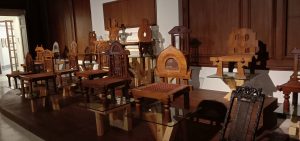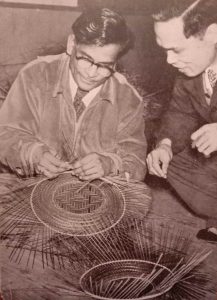Who was Upendra Maharathi?
At the NGMA in Delhi, a massive retrospective of the artist-architect included more than a thousand of his works, including a stunning collection of classical Mauryan chairs designed for Buddhist monasteries
Archana Khare Ghose
Contemporary India, including the creative community, has all but forgotten the multi-faceted artist-architect, who passed away at the age of 73 in 1981. Even the Director General of the National Gallery of Modern Art (NGMA), Adwaita Gadanayak, admits he didn’t know about him till his visit to Patna a few years ago.
‘In Patna, I noticed the unique design of the Railway Station and the Guest House and discovered that the name behind the structures was Upendra Maharathi. Soon, I found out that the Sabha Mandap and the Arts College too were designed by him. That got me curious and upon asking, I discovered his stamp all around the city. This led me to a more comprehensive research and I realised what a treasure I had hit upon; it needed to be brought out in public,’ shares Gadanayak, who spent nearly three years visiting several places in Bihar to collect information and material on Maharathi.

Gadanayak’s research led to the massive retrospective of Maharathi’s oeuvre, titled Shashwat — Maharathi: The Eternal Seeker featuring more than 1,000 works, objects and installations that was shown recently at the NGMA New Delhi. It opens at NGMA Bengaluru on March 28 and is slated to next travel to museums in Bihar and Orissa – the former where he built his life, and the latter where he was born in 1908. It may also go to Kolkata, where Maharathi studied at the Government College of Art from 1925-1931.
The Delhi retrospective featured Maharathi’s paintings, drawings, photographs of the buildings he designed (such as the Nalanda Railway Station and others in Gaya and Rajgir), photographs of his work for Indian National Congress sessions during the freedom struggle, textile designs, documents, bamboo baskets, ceramics, and a meditation hall depicting the essence of his architectural designs. A common feature of Maharathi’s works – who had turned Buddhist in later years – is the perceptible influence of Buddhist art and principles.

The standout act, however, was the stunning collection of classical Mauryan chairs designed for Buddhist monasteries, made of wood and jute, but without nails. Standing amidst the low-rise chairs, one felt transported to the ancient times, or at least to the sets of the historical television series ‘Chandragupta’ set in the Mauryan Age. Especially alluring were the chairs’ backrests, inspired by Buddhist chaityas; one could easily make out the outlines of famous Buddhist monuments, such as the Barabar caves or the Sanchi stupa, to name some.
‘Given the living presence of his work all around Bihar, it’s a surprise he never had an exhibition in his lifetime, nor does he find mention in any easily-accessible document. He was even awarded the Padmashri in 1969. How did we forget him? Luckily, his family in Patna still has many of his works and readily collaborated,’ shares Gadanayak.

Maharathi’s only child, his daughter Mahashweta, is overwhelmed at the breadth of the NGMA exhibition. ‘I’m glad his work is eventually going to reach out to the public through this exhibition,’ she says.
Share